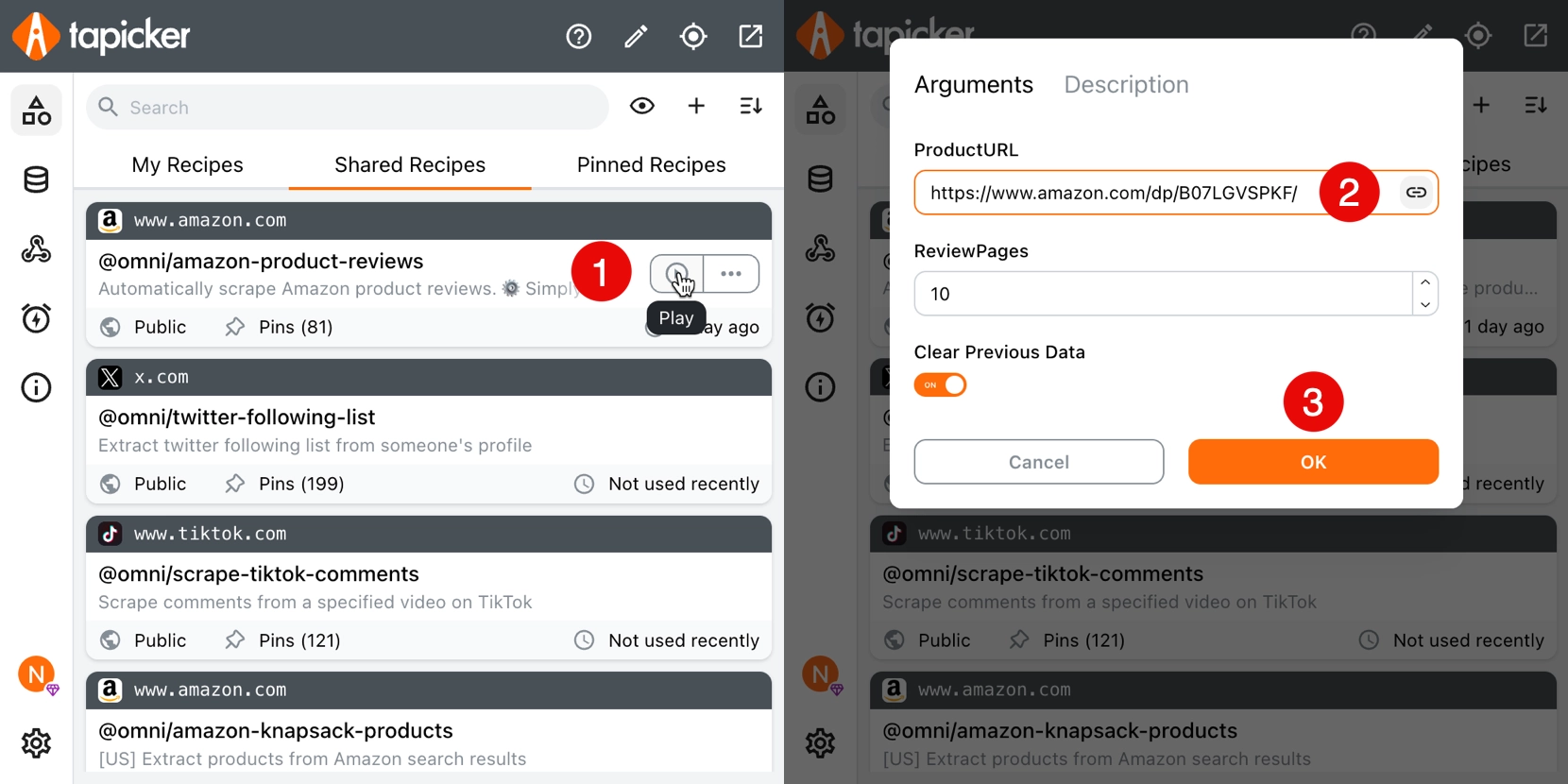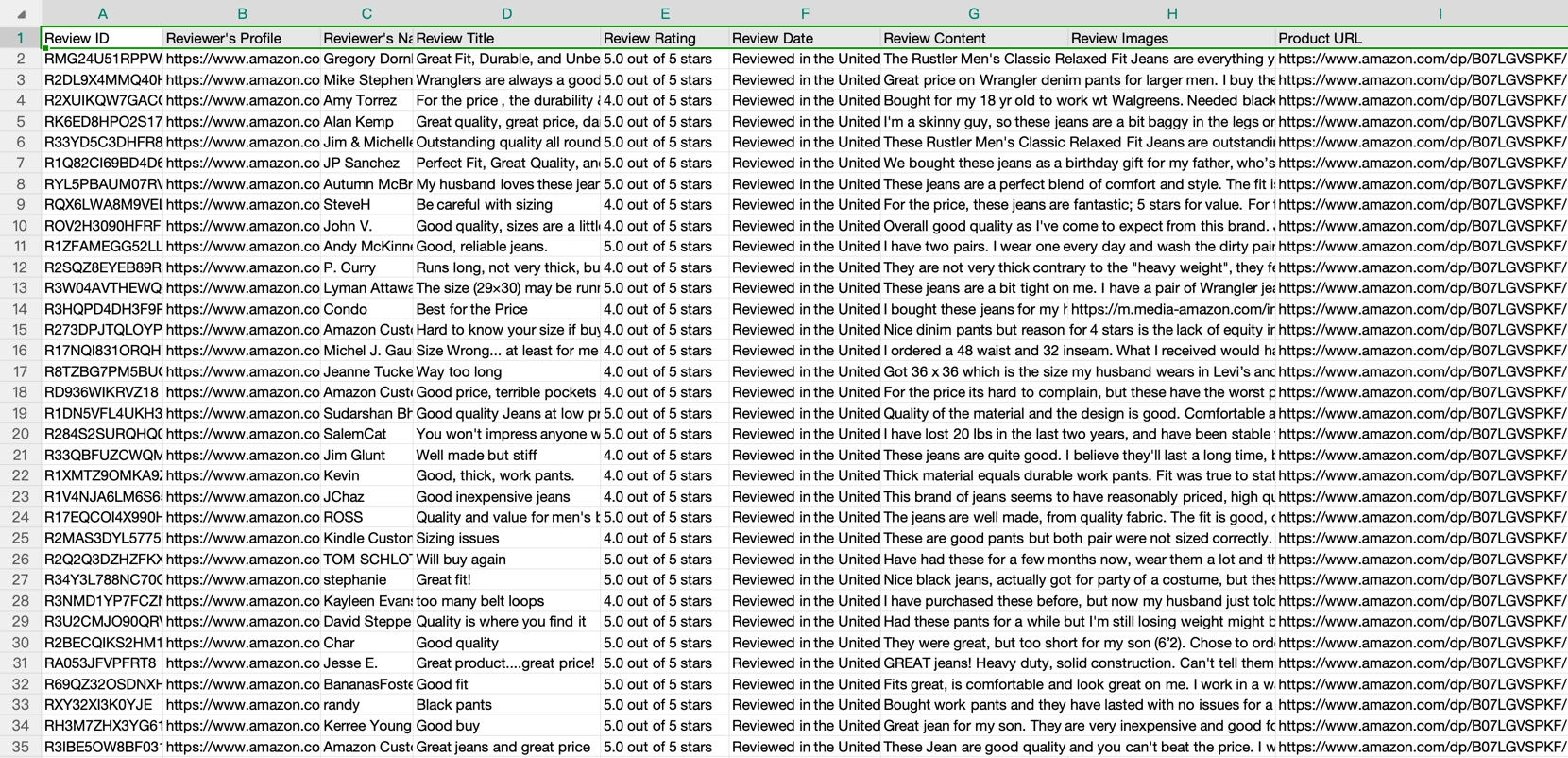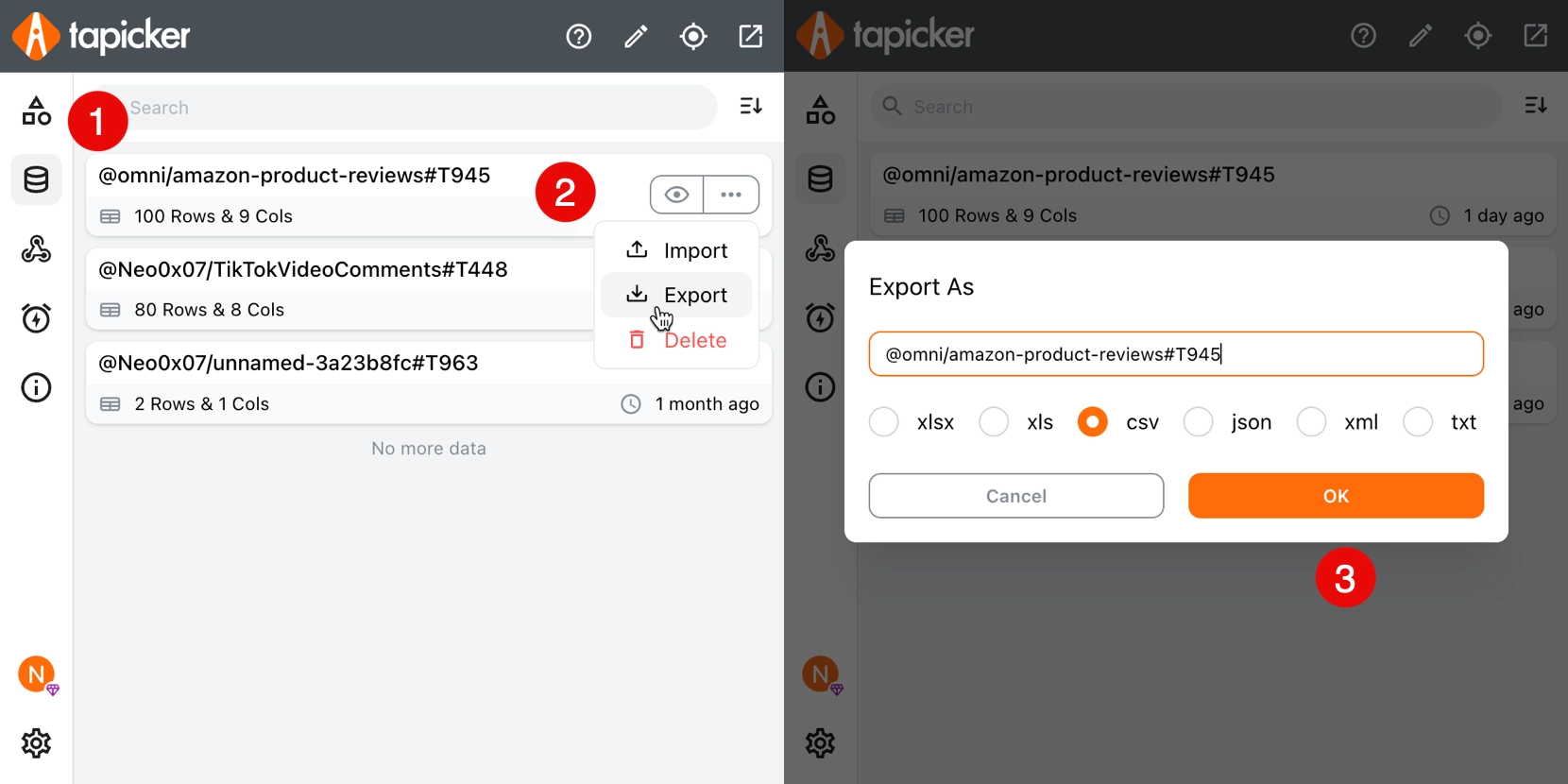If you do product research, reputation monitoring, or competitive analysis, Amazon reviews are a goldmine. The challenge has always been getting them out of Amazon and into a spreadsheet you can analyze. In this guide, you’ll learn exactly how to export Amazon reviews—including a free method—using Tapicker’s prebuilt recipe, @omni/amazon-product-reviews. You’ll see how to turn any product page into a clean CSV file you can open in Excel or Google Sheets, without writing code and without babysitting the browser.
Along the way, we’ll cover how Tapicker compares to a typical Amazon review extractor extension, how to avoid common pitfalls (like pagination and hidden reviews), and how to make the most of the data once you’ve exported it.
Why Export Amazon Reviews?
Before we jump into tooling, it helps to clarify what makes review data so valuable:
- Voice of customer: Pull the most common pain points and feature requests straight from real buyers.
- Competitor insights: See where competing products overperform or underwhelm.
- Keyword discovery: Mine phrases customers actually use—helpful for SEO, PPC, and listing optimization.
- Star distribution & trends: Track rating changes over time to spot quality issues or review manipulation.
- Feature sentiment: Connect specific attributes (battery life, material, sizing) to positive or negative sentiment.
To do any of this, you need reviews in a structured format. That’s why so many teams search for an Amazon review extractor or an Amazon review downloader free option that can export Amazon reviews to CSV reliably.
Meet Tapicker: Your Amazon Review Extractor (That Actually Works)
Tapicker is a browser automation tool (think of it as a smart, no-code web robot) that ships with ready-made “recipes” for common tasks. For Amazon reviews, Tapicker provides a plug-and-play recipe.
Install Tapicker (Chrome extension)
Tapicker is a very lightweight browser extension that works on Chrome and Edge. If you haven't installed it yet, you can go to the Chrome Web Store or Edge Add-ons Store to install it with one click.
And then you can find the recipe in Shared Recipes: @omni/amazon-product-reviews.
How it works:
- Play the recipe.
- Paste the product page URL.
- Hit OK when you are ready.

Tapicker will:
- Load the product page
- Scroll to the reviews section
- Click “See more reviews” to open all reviews page
- Collect fields (reviewer’s name, rating, title, content, date, etc.)
- Normalize the data into rows
In most cases, it finishes in about a minute per product URL. That’s faster than copy-pasting and far more reliable than ad-hoc scripts.
Once done, Tapicker offers a CSV export. You now have a clean file that you can open in Excel, Numbers, or Google Sheets.
If you’ve tried other tools that stall on infinite scroll, miss half the reviews, or choke on pagination, this is a breath of fresh air.
That’s it. If you came here searching how to export Amazon reviews free, this is the simplest route.
Note: Tapicker offers a free tier suitable for quick tasks and trials. For high-volume export, consider upgrading, but the core flow is the same.
What Fields Can You Expect in the CSV?
Depending on the product and region, Tapicker typically captures:
- Review ID: A unique identifier for the review, usually generated by Amazon.
- Reviewer's Profile: The URL to the reviewer’s Amazon profile page.
- Reviewer's Name: The display name of the person who posted the review.
- Review Title: The short headline the reviewer gave their review.
- Review Rating: The star rating given by the reviewer (1–5 stars).
- Review Date: The date the review was posted, shown in the locale’s date format.
- Review Content: The full body text of the review, including all expanded “read more” sections.
- Review Images: Links (URLs) to any images the reviewer uploaded with their review.
- Product URL: The Amazon product page link from your entered.
Here is what exporting Amazon reviews to an Excel file looks like.

The exact set may vary by listing (some regions or categories format reviews slightly differently), but the CSV is designed to be consistent enough for bulk analysis.
How to export Amazon reviews to CSV file?
After the recipe is finished running, to export Amazon reviews to an CSV file, just follow the steps below.
- Navigate to the Data Center page.
- Find the dataset with the same name as the recipe and click "Export".
- Select CSV format and click "OK".

How to export Amazon reviews to Google Sheets?
If you also want to export Amazon reviews to Google Sheets, you can do so.
- Open Google Sheets.
- Click “File” > click “Open”.
- On the popup, click the “Upload” tab.
- Click the “Browse” button and select the CSV file.
- The Amazon reviews data is now exported to Google Sheets.
If you want to be smarter about this process, you can also build your own recipes and then use Google Sheets block instead of manual exports.
Export Amazon Reviews Free: What You Can Do on Tapicker’s Free Tier
If you’re specifically looking for an amazon review downloader free, Tapicker’s free tier is ideal for:
- Trying the flow end-to-end
- Exporting a limited number of reviews (1,000 rows)
- Validating fields and structure before scaling
For larger datasets, scheduling, or multi-URL batches, the paid tiers save time. But the free experience will give you a genuine sense of how well the amazon review extractor works and whether it fits your workflow.
Why Use Tapicker Over a Typical Amazon Review Extractor Extension?
Plenty of browser add-ons promise to export reviews. Here’s why Tapicker stands out:
1) Prebuilt recipe = fewer steps
@omni/amazon-product-reviews abstracts away the fiddly bits—scroll timing, “read more” clicks, pagination, and locale quirks.
2) Automation-first
Tapicker is built for web automation, not just scraping. That means it can click, wait, and adapt like a human—crucial on dynamic review pages.
3) Cleaner CSV
Many extensions dump raw HTML or partial fields. Tapicker gives structured CSV that analytics teams can use immediately.
4) Scales to your workflow
Start with a single product, then grow to multiple URLs. The same UI and logic applies.
5) Transparent and controllable
Because it’s recipe-driven, you can see exactly what it does and adjust parameters in advanced use cases.
If your goal is to export Amazon reviews to CSV reliably—without constant manual babysitting—Tapicker’s approach is both faster and more robust than most one-off amazon review extractor extensions.
Best Practices for Review Exports (So Your Data Is Actually Useful)
Even with a great extractor, a few habits can dramatically improve data quality:
1) Choose the right region & language
Amazon domains vary by country (.com, .co.uk, .de, etc.). Reviews differ by region. Export from the market you sell or analyze in.
2) Capture enough volume
Small samples can mislead. If the product has thousands of reviews, consider:
- Exporting the full set (time permitting)
- Or scoping by date range (e.g., last 12 months) to capture current sentiment
3) Keep first-run and follow-up runs separate
If you plan to monitor changes, save your first CSV as a baseline, then append new exports by date to track trends over time.
4) Normalize dates immediately
Amazon displays dates in localized formats (“Reviewed in the United States on May 3, 2025”). Normalize them to ISO (YYYY-MM-DD) to simplify charts and filters.
5) Deduplicate when comparing runs
If you export the same product multiple times, use Review ID or a composite key (e.g., Reviewer's Name + Review Date + Review Title) to avoid double counting.
6) Tag variations
If the listing bundles multiple variants (color, size), create a Variant column. This helps identify whether negative sentiment clusters around one particular variant.
From CSV to Insights: What to Do Next
Once you export Amazon reviews CSV file, here are practical next steps:
A) Quick EDA (Exploratory Data Analysis)
- Star distribution: Count reviews by rating (1–5).
- Trend over time: Group by month to check if ratings rise or fall.
- Helpful votes: Prioritize reviews with higher helpful counts—they’re more influential.
B) Keyword & Topic Discovery
- Split review text into tokens
- Remove stopwords
- Count top bigrams/trigrams (“battery life”, “true to size”, “customer service”)
- Map topics to average rating to see which themes drive satisfaction/complaints
C) Sentiment Buckets
- Simple rule-based (positive/negative/neutral by rating)
- Or use a basic sentiment model offline to score the text.
- Compare feature mentions (e.g., “strap”, “firmware”, “waterproof”) against sentiment for targeted improvements.
D) Competitor Benchmarking
Export competitor products with the same method. Build a comparison sheet:
- Average rating, median rating
- Sentiment by feature
- % of “Verified Purchase”
- Return/replacement anecdotes frequency (proxy for quality issues)
E) Review Response Playbook
If you manage a brand, create templated responses based on common pain points and escalate patterns to product teams. Close the feedback loop with real customers.
Troubleshooting: When Review Export Doesn’t Look Right
Issue: Reviews seem truncated.
Fix: Tapicker expands “Read more”, but if you still see truncation, re-run with a slightly longer wait time between scrolls (advanced setting).
Issue: Not all pages exported.
Fix: Some products paginate in unusual ways (e.g., filters by star rating). Ensure no filter is active and try again. If the listing is massive, split by date range or run multiple passes.
Issue: Mixed languages in one CSV.
Fix: Amazon sometimes mixes review locales. If you need a single-language dataset, filter by domain or by detected language field after export.
Issue: Duplicate rows in merged datasets.
Fix: Deduplicate on Review ID or a composite key.
Issue: “About a minute” took longer.
Fix: Large or media-heavy review sections need more time. Network conditions and captcha checks can also slow runs. Try again or reduce the page range.
Is It Legal to Export Amazon Reviews?
This guide isn’t legal advice, but here are general guidelines:
- Respect Amazon’s Terms of Service. Only collect publicly available data and use it in ways that comply with the site’s rules.
- Avoid heavy load. Don’t hammer endpoints or run massive parallel jobs that could degrade service.
- Honor privacy. Don’t attempt to infer or collect sensitive personal information.
- Use data responsibly. Reviews are public opinions; use them ethically and store them securely.
Tapicker is an automation tool that acts like a user browsing a page. Always use it thoughtfully and within policy boundaries.
Frequently Asked Questions
Q1: Can I export Amazon reviews free?
Yes. Tapicker offers a free tier suitable for quick tasks. If you need to export at scale, you can upgrade, but the process—paste URL, run, download CSV—remains the same.
Q2: What’s the difference between Tapicker and an Amazon review extractor extension?
Many extensions are single-purpose and brittle. Tapicker is automation-first with a prebuilt recipe that handles pagination, expand/collapse, and timing, producing cleaner CSVs with fewer misses.
Q3: How long does it take?
Most single-product runs complete in about a minute, depending on review count and network conditions.
Q4: Can I export images or videos from reviews?
Tapicker records whether images are present and may capture their URLs when accessible. For media-heavy workflows, validate fields on a sample first.
Q5: Does it work on all Amazon locales (.com, .co.uk, .de, etc.)?
Yes, with typical layouts. Edge cases exist, so test your target locale on a sample product.
Q6: Can I export only recent reviews?
Yes—run the recipe and filter by Review Date in your spreadsheet, or segment runs by date windows for large products.
Q7: How do I keep the data up to date?
Re-run the recipe on a schedule (weekly/monthly) and append only new reviews by deduplicating on Review ID or a composite key.
Q8: Will this work for products with tons of variations?
Generally yes. If the listing’s variation logic is complex, export by specific variant URL to ensure clarity.


